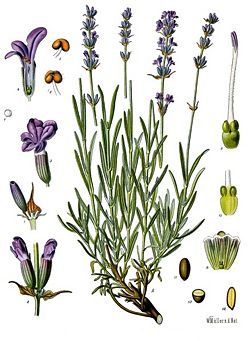Lavandula angustifolia
| Lavandula angustifolia | ||||||||||||||
|---|---|---|---|---|---|---|---|---|---|---|---|---|---|---|
 Common Lavender (Lavandula angustifolia)
|
||||||||||||||
| Scientific classification | ||||||||||||||
|
||||||||||||||
| Binomial name | ||||||||||||||
| Lavandula angustifolia Mill.[1] |
||||||||||||||
| Synonyms | ||||||||||||||
Lavandula angustifolia (also Lavandula spica or Lavandula vera; common lavender, true lavender, or English lavender (though not native to England); formerly L. officinalis) is a flowering plant in the family Lamiaceae, native to the western Mediterranean region, primarily in the Pyrenees and other mountains in northern Spain.
It is a strongly aromatic shrub growing to 1–2 m tall. The leaves are evergreen, 2–6 cm long and 4–6 mm broad. The flowers are pinkish-purple (lavender-coloured), produced on spikes 2–8 cm long at the top of slender, leafless stems 10–30 cm long.
The species name angustifolia is Latin for "narrow leaf".
Contents |
Cultivation
English lavender is commonly grown as an ornamental plant. It is popular for its colourful flowers, its fragrance and its ability to survive with low water consumption. It does not grow well in continuously damp soil. It is fairly tolerant of low temperatures, generally considered hardy to USDA zone 5.[2]
Use
In addition to its use as an ornamental plant, the flowers and leaves are also used as an herbal medicine, either in the form of lavender oil or as an herbal tea. The flowers are also used as a culinary herb, most often as part of the French herb blend called herbes de Provence.
Lavender essential oil, when diluted with a carrier oil, is commonly used as a relaxant with massage therapy. Products for home use including lotions, eye pillows—including lavender flowers or the essential oil itself—bath oils, etc. are also used to induce relaxation.
Subspecies
References
- ↑ 1.0 1.1 1.2 1.3 1.4 1.5 1.6 "Lavandula angustifolia information from NPGS/GRIN". www.ars-grin.gov. Retrieved on 2008-04-12.
- ↑ USDA Plant Hardiness Zone Map. Retrieved on 2008-05-22.
External links
- Lavender fields in the Provence
- Lavandula angustifolia List of Chemicals (Dr. Duke's Databases)
- Lavandula angustifolia Plants for a Future
See also
- Xeriscaping
|
||||||||||||||||||||||||||||||||||||||||||